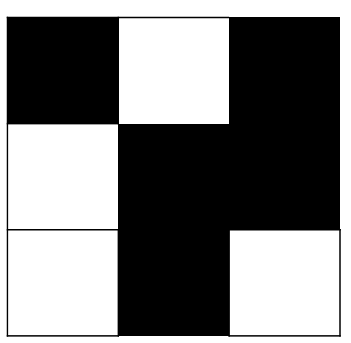Another Minefield
The image below shows a 3 × 3 grid with some cells shaded.

The 3 × 3 grid corresponds to the number grid:
1 3 2 4 2 1 2 2 3
Now, I present to you a new number grid:
4 4 ? 3 4 4 3 5 5 3 4 2 3 5 2 4
If the same rule applies, what is the number that should be filled in the "?" cell ?
This section requires Javascript.
You are seeing this because something didn't load right. We suggest you, (a) try
refreshing the page, (b) enabling javascript if it is disabled on your browser and,
finally, (c)
loading the
non-javascript version of this page
. We're sorry about the hassle.
1 solution
Not sure whether there exists an algorithm that you can follow to obtain the actual configuration, but regardless, it would still make a fun logic game.
In this case, since the sum of numbers in the grid is divisible by 6, we know that there are 6 0 ÷ 6 = 1 0 black cells and 6 white cells.
Notice that there's exactly one cell with a 5 in each row and column, that implies among the other 12 cells, exactly 2 of them are white and the white cells cannot see each other. Since only 2 of the other 12 cells are white and we know that there are 6 white cells, that means that the four 5 s must be white! With that, the rest of the configuration can be easily deduced, and I'll leave the rest to you. :D
Log in to reply
Nice deduction. If my configuration is sth like 9 black, 7 white or 8 black, 8 white, can it still be deduced like that? Actually, I was pondering whether if I leave two slots in "?", is the problem still solvable.
Log in to reply
For arbitrary grids, one might need to look for other patterns to use for their advantage, they might also need to use more complex logical reasoning.
It's probably still solvable, though you need a way to prove that only one out of the other possible configurations is possible.
Do take note that the rule applied here is the number in each cell is the sum of number of cells shaded in the same row and same column as it is, excluding itself.
It seems like we have to know the actual configuration of shading to be able to solve this. In reality, you need not .
Do take note that each time one cell is shaded, the sum of all numbers in the number grid is increased by 6 because 6 cells are "looking" at the shaded cell.
In other words, the sum of numbers in the number grid is divisible by 6 .
Let the number to be filled in the "?" cell be x .
The sum = 4 + 4 + 5 + 3 + 4 + 4 + 3 + 5 + x + 3 + 4 + 2 + 3 + 5 + 2 + 4 = 4 9 + x
5 5 + x is divisible by 6 .
Since 0 ≤ x ≤ 6 ,
We deduce that x = 5 .
Since this is my own problem, I know the actual configuration. It looks like this:
However, I have no idea on how to compute the configuration by merely looking at the number grid. Hope someone could help.